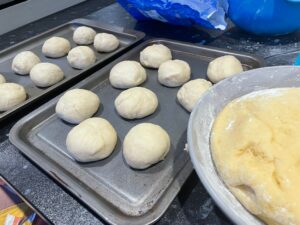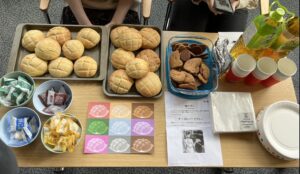グループ3の一年生の学園祭
今学期の四週目、私たちは日本の学生に学園祭について色々な質問を聞きました。日本の学生は食べ物の屋台がいちばんすきだとこたえました。そして、日本で人気があるので、メロンパンとクッキーを作ると決めました。屋台のデコレーションやポスターも作りました。
メロンパンは日本の伝統的なお菓子です。メロンパンといってもメロンは入らなくて、パンとクッキーを作らせたメロンっぽいパンです。日本で子供にも大人にもとても人気があります。こういうお菓子は可愛くてさっぱりです、そして、メロンパンは作りやすくたそうですから、メロンパンを作ることにしました。まず、生地を作りました。パン生地を作りました。でも、すごくべたべ
 たパンですから、作るのはとても難しかった。記事がふくらまのを待っているまに、パンにのせるクッキー生地を作りました。それから、生地を四つのつのぶぶんにわかれて、つぎ十六のぶぶんにわかれました。私たちはそれらをボールに転がして、パン生地にクッキー生地をのせました。次、パイナップルのデザインを作成するためにクッキー生地にスコアをつけて、四十五分間ぐらいをふくれ上がりました。三十分ぐらいメロンパンをやきまして、一のを食べました。とてもおいしかったです!
たパンですから、作るのはとても難しかった。記事がふくらまのを待っているまに、パンにのせるクッキー生地を作りました。それから、生地を四つのつのぶぶんにわかれて、つぎ十六のぶぶんにわかれました。私たちはそれらをボールに転がして、パン生地にクッキー生地をのせました。次、パイナップルのデザインを作成するためにクッキー生地にスコアをつけて、四十五分間ぐらいをふくれ上がりました。三十分ぐらいメロンパンをやきまして、一のを食べました。とてもおいしかったです!
当日、12時にやたいをじゅんびしました。お茶やメロンパンやクッキーだしました。私たちのメロンパンはとても人気があって、あっという間に売り切れました。学生と先生はおいしいと言ってくれました。
たくさんの屋台を見ました。隣の屋台ではクイズをやっていて、日本の県を一番多く正解した参加者が優勝、好きなお菓子がもらえました。御神籤は屋台で配られました、片面には運勢が書かれて、もう片面には人生助言が書かれました。日本の詩が書かれた御神籤もあり、違った意味を鑑賞できます。特筆べ きは、これらが全部手書きで、とてもきれいに作られていることです。 めっちゃ楽しい時間を過ごしました。

In week 4 of this semester, we talked to Japanese students about gakuensais’ within Japan. We asked various questions, such as what their favourite gakuensais’ were in Japan. We then found that overall, the Japanese students said they liked food stalls the best. We then decided to make melon pans and cookies as they are popular baked goods in Japan. People also made things like posters and decorations for our stall.
Melonpan is a kind of traditional dessert in Japan. Although it is called a melon pan, there is no melon in it. It is made with sweet bread with cracked cookies on the top, making the dessert look like a melon. After baking, the bread becomes sweet and crispy, so it is quite popular among not only children but also adults in Japan. Desserts in Japan are different to those in Europe as Japanese bakeries almost consist of danngo or mochi such as dorayaki and annmitu which both look cute and taste mild. Since melon pan looks easy to make, we decided to choose it as a representative of Japanese desserts.
We made lots of melon pans while listening to good music. We started by making the dough for the bread. However, it was very difficult to make because it was really sticky. When we were waiting for the dough to rise, we made the cookie dough on the bread. After this, we separated the dough into four sections and then into 8 and then 16 sections. We rolled them into balls and put the cookie dough on top. Then, we scored the cookie dough to create a pineapple design and let them rest for 45 minutes. We then baked them for 30 minutes and tried one melon pan to see if it tasted good. It was so delicious!

On the day of Gakuensai, we arrived at 12 to set up our stall. We had a melon pan made by the first years, and cookies made by Keith as well as drinks and mochi. We set up the stall quite quickly since the design was simple, so we were able to chat with our stall neighbours and see what other groups were up to. Once Gakuensai started, our melon pan was very popular and they sold out very quickly. We all said that perhaps we should have made more, they were very large so we could have made them smaller to have more to sell. Some of our teachers came to the stall and ordered in Japanese. After the melon pan sold out, we were also able to sell a lot of the cookies.
Overall we made about £25, which meant we made about £3 each, enough for us to spend on our classmates’ stalls! We saw many stalls. Hanafuda is not only visually pleasing but also interesting. At the stall next to us, they were having a quiz, and the participant who got the most Japanese prefectures right won and received sweets of their choice. At another stall, Omikuji were handed out there, with fortunes written on one side and life advice on the other. There was also Omikuji with Japanese poetry on it for each to appreciate. What’s worth mentioning is that these items are all hand-written and very nicely done. We had lots of fun




Recent comments